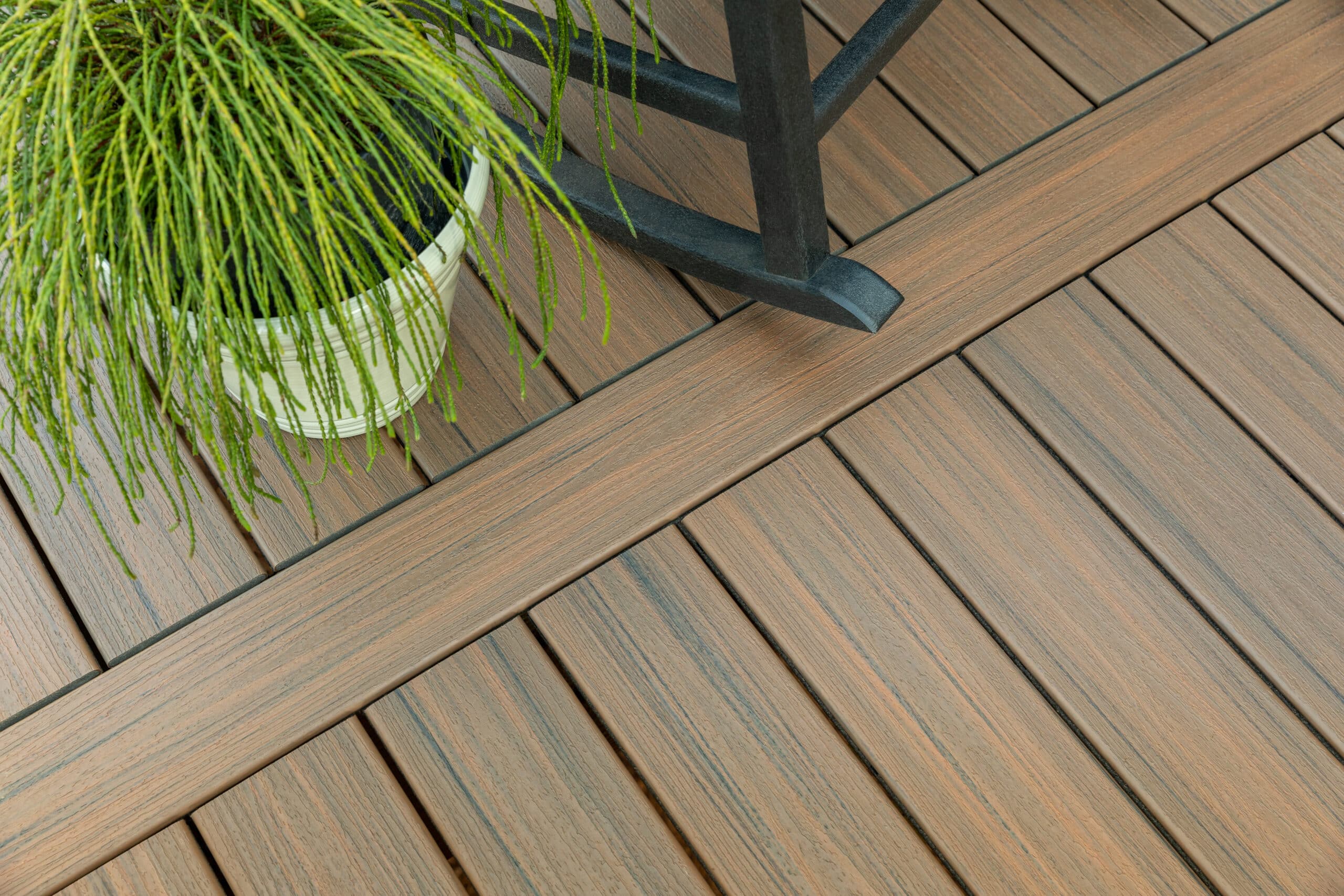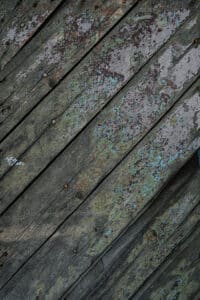
Replacing Your Wood Deck with Composite Decking: Easy Guide
Wood decking requires regular maintenance to stay in good shape. Homeowners who underestimate the amount of work that goes into a wood deck can end up with a rotted, splintery mess before they know it. Instead of demolishing your deck for good, consider replacing your wood deck with a more low-maintenance option.
Manufactured decking materials such as composite and PVC are great alternatives for homeowners who like the appearance of wood but don’t like the upkeep. And replacing wood boards with manufactured decking is easier than you might think — in this guide, you’ll learn everything you need to know about the resurfacing process and replacing deck boards with composite.
When to Replace Your Wood Deck

Image by ArthurHidden on Freepik
Your old deck boards should be replaced if the wood has become rotten, is badly splintered, or has begun to deteriorate. A damaged deck isn’t just unsightly; it’s unsafe to use and should be repaired or replaced as soon as possible to avoid injury. Replacing deck boards with new composite decking is worth it if you have noticed any of these issues.
Why Make the Switch to Composite Decking?
As we’ve mentioned, manufactured decking materials like composite boards and PVC require far less maintenance than wood. They’re easier to take care of and are naturally more resistant to moisture, insects, and splintering; they also tend to last longer than wood boards.
Some other benefits of manufactured decking materials include:
- Heat resistance (lighter colors are cooler on bare feet)
- Scratch resistance
- Made from recycled materials
- Fade resistance (UV protection)
Cost of Replacing Wooden Deck Boards
New composite deck boards can often be installed on an existing deck substructure (the posts, joists, and beams that hold up your wooden deck). This significantly cuts the cost of replacement.
Manufactured deck boards cost more than most types of wood upfront, but the long-term savings on maintenance and long lifespan make up for it.
How to Replace Deck Boards: Step by Step
You can either hire a contractor to replace your deck for you, or you can do it yourself. If you choose to go the DIY route, here are some terms you should know.
- Posts: The vertical supports that hold up the deck.
- Beams: Horizontal supports that frame the deck.
- Joists: Also called secondary beams, joists are smaller and span between two beams. These slats are what you’ll place the new deck boards on top of.
- Fasteners: The nails or screws that hold your deck together.
Remove the Wood
This is the most physically demanding part of the resurfacing process. The most common way to remove wood deck boards is to use a hammer and a pry bar. However, there are several different techniques you can try, such as this two crow-bar method.
Look for Sagging Joists
Once the wood has been removed, you’ll want to check for sagging joists. The easiest way to do this is to take a string and stretch it from one end of the deck frame to the other so that it’s straight. From the side, you should be able to see if the joists line up with the string.
If the joists aren’t even, shim or shave them down until they are nice and level.
Check Joist Size and Spacing
You’ll also want to inspect the joist placement of the current substructure for your wood deck replacement. Most manufactured decking materials come in 1×6 boards and cannot be placed on joists more than 16 inches apart.
Most pressure-treated wood, on the other hand, comes in 2×6 boards and can be placed on joists as far as 24 inches apart. You may have to make adjustments to the spacing of your joists so that they’re strong enough to hold your new manufactured boards, which tend to be slightly heavier than wood.
Inspect Your Fastening Systems
Next, you’ll want to inspect the fasteners holding your substructure together. If the nails or screws have become loose or significantly corroded, tighten or replace them altogether. Again, manufactured decking materials tend to be heavier than pressure-treated wood, so having a strong foundation is essential.
Install the New Manufactured Decking
Finally, with the old wood decking removed and the knowledge that your substructure is strong enough, you can begin to install your new manufactured deck boards.
Each brand of decking will have its own detailed installation guide that you’ll want to follow carefully. But to summarize the process, you’ll need to make notches in the first row of decking so that it fits around the posts.
From there, it’s as simple as lining up your new boards and securing them to the joists with your choice of fastener. Older decks often used nails, but for your newly resurfaced deck, we recommend a more attractive and durable option like deck screws or hidden fasteners. Once all of the boards are installed, all that’s left to do is trim the edges and enjoy your new and improved deck!
Maintaining Your New Deck’s Appearance
So, now you have brand new composite or PVC replacement boards on top of your old (yet still structurally sound) deck’s substructure. While new technology has allowed manufactured decking to look more like real wood than ever before, the difference in color and texture may still be noticeable. The beams and joists will be hidden by the new boards, but the posts often extend up into your deck railing.
How do you keep these two different materials from clashing?
Luckily, composite decking manufacturers have come up with a simple solution. They will often have composite post sleeves and stair treads you can use to cover your wooden surfaces for a more cohesive finished look.
Full Deck Replacement
You may find that you require (or want) a complete deck replacement. A full deck replacement is when you tear down and replace the entire deck structure. This includes the following:
- Deck railings
- Deck surface
- Deck substructure
Often, problems with the deck’s surface can be managed with repairs. But problems with the substructure indicate a total replacement may be necessary because the structural integrity is at risk. This poses a dangerous situation for deck users.
Of course, an entire deck replacement cost is higher than a deck repair. But a complete replacement is necessary when you have persistent and dangerous deck problems, such as water damage and rot. To determine if you need a complete deck replacement, go through this short checklist.
1. Assess Your Deck’s Health
You can assess your deck’s health by thoroughly inspecting the deck’s surface and substructure. Some deck problems to look for are:
- A loose ledger board (the part that secures the deck to your home)
- Mildew, mold, and rot
- Rusted or loosened fasteners
When to Repair
You may notice a small gap between the ledger board and your home. This is normal and is caused by a build-up of debris. Simply remove the debris and tighten the fasteners.
If there are small, localized areas of rot, mold, or mildew on the deck’s surface, you can easily treat them. A deck professional will help you determine whether you should use a deck cleaner or replace the damaged boards.
Having a few rusted, loose, or protruding fasteners is nothing to worry about. You can easily replace rusted fasteners with new ones, tighten the loose fasteners with a screwdriver, and hammer in protruding fasteners.
You can make most of these repairs yourself with minimal carpentry skills. However, you can always hire a deck professional if you feel more comfortable doing so.
When to Replace
If the ledger board is pulling away from your house because it’s damaged (likely from rot), you’ll need to replace it. Remember, pervasive rot on the deck’s substructure weakens its structural integrity. Widespread rot on any part of the deck calls for a total deck replacement.
An excessive amount of rusted or loose fasteners also indicates that you have extensive rot or insect damage. Again, this will require a complete deck replacement.
2. Consider Your Deck’s Longevity
How much longer do you plan to use the current deck in your outdoor living space? How many more years would you like to get out of your deck before considering a complete replacement?
By answering these questions, you’ll know whether repairing your deck is more cost-effective or spending on a complete deck replacement.
For instance, if you’ll be moving in the next few years, you can repair your deck. This is unless your deck has structural issues. Leaving structural problems as-is could negatively affect your property’s value when you go to sell.
If you don’t plan to move, a full replacement could be just the upgrade your outdoor space needs! Make it your home improvement project for the year, and get excited about having a new deck. This time, choose higher-quality materials, like composite, for even better returns and less maintenance.
3. Evaluate Repair and Replacement Costs
Finally, assess the cost of a deck repair versus deck replacement. With an idea of the current condition of your deck and your future plans, you can evaluate whether a repair or replacement is best.
Unfortunately, you won’t be able to calculate these costs on your own, though, so you’ll need to contact a deck repair contractor for an estimate.
Deck Replacement FAQs
Even with all the information we’ve provided about replacing your deck, you may still have questions. Let’s review homeowners’ most frequently asked questions about deck replacements.
Is It Cheaper to Repair or Replace a Deck?
This all depends on the condition of your deck. If you have mild problems with the deck’s surface, it’ll be more cost-effective to perform repairs.
However, if you have structural problems, it will be cheaper, in the long run, to opt for a complete deck repair. Although the initial costs will be higher, you’ll have a greater return on investment.
Here’s a good rule to follow: if the cost of repairs is close to (or even greater than) the cost to entirely replace your deck, you should probably just choose the replacement.
Can I Just Replace Deck Boards?
Sometimes, you can! When assessing your deck’s health, you will have a better idea of how much damage there is to the deck and where the damage is located.
Should your deck’s substructure still be in good condition, you can simply remodel your outdoor space with new decking, handrails, and stairs. This will help significantly reduce your deck-building costs for this project.
If you’re unsure whether you can replace your deck boards without going for a total deck replacement, contact a deck expert.
How Much Does It Cost to Redo a Wood Deck?
According to data from HomeAdvisor, the average complete deck replacement is between $4,000 and $11,000. Cost factors include:
- Labor
- Materials
- Size
The cost of labor varies depending on your location. For example, in Florida, you can usually expect to pay between $15 and $30 for labor. However, the cost of labor depends upon how reputable and experienced your decking contractor is.
The price of a full wood deck replacement will vary depending on the wood you choose. For example, treated lumber ranges from $3-8 per square foot, while composite or PVC can range from $5-20 per square foot. Naturally, the size of your deck and the material you choose will affect the final cost of your deck project.
It’s important to consider not just the material you use but also its longevity and maintenance requirements. Spending more on materials upfront to cut maintenance costs and extend your deck’s lifespan is a better long-term investment.
Further, if your substructure is still functional, replacing just the deck boards will significantly reduce how much you spend, regardless of the materials you choose.
How Often Do Wood Decks Need to Be Replaced?
Traditional wood decks only have a lifespan of 10 to 15 years. Wood is highly vulnerable to moisture and weather elements, which lessens its lifespan. Therefore, at some point, a complete deck replacement will become inevitable.
Where to Find Decking Materials for Your Resurfacing Project
Resurfacing an old deck is an incredibly rewarding DIY project. To get the job done, you’re going to need quality decking materials, tools, and hardware.
As a leading supplier of marine construction materials in the southeastern United States, Decks & Docks Lumber Co. has everything you need to get the job done right. Visit one of our coastal locations or give us a call for more information. If you ever get stuck, we’re always happy to offer advice!
- About the Author
- Latest Posts
Dan has worked for Decks and Docks for over twenty-five years. He managed the original Decks and Docks store in St. Pete, which is our largest store. Dan is simply the best all around. He knows more about this company and our products than probably anyone else. Dan currently works in Sales at our corporate office.
